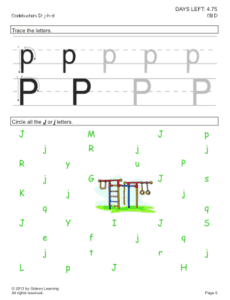With typing on keyboards becoming the norm and cursive seemingly becoming a lost art, does handwriting matter? Does it help us in any way? The article, How Handwriting Trains the Brain, at WSJ.com highlights new research which proves it be beneficial in cognitive skills for young and old alike.
The practice helps with learning letters and shapes, can improve idea composition and expression, and may aid fine motor-skill development. It’s not just children who benefit. Adults studying new symbols, such as Chinese characters, might enhance recognition by writing the characters by hand, researchers say.
We apply this at Gideon in our curriculum. Students who are in our beginning reading level of learning letter names and sounds practice tracing the letters over and over. While mastery at that level isn’t determined by the writing abilities, we know it only aids their memory formation.
Older students must write out vocabulary words five times to ensure each word’s spelling is solid in their minds. Math students write the answers to addition facts over and over for memorization.
Studies suggest there’s real value in learning and maintaining this ancient skill, even as we increasingly communicate electronically via keyboards big and small.
MRI scans were done on young students after varying instruction on letters.
In children who had practiced printing by hand, the neural activity was far more enhanced and “adult-like” than in those who had simply looked at letters.
“It seems there is something really important about manually manipulating and drawing out two-dimensional things we see all the time,” says Karin Harman James, assistant professor of psychology and neuroscience at Indiana University who led the study.
Another study had adults practice learning new symbols by hand or by keyboard. The results were similar to the children showing that everyone can benefit from pen and paper writing.
For those writing by hand, there was stronger and longer-lasting recognition of the characters’ proper orientation, suggesting that the specific movements memorized when learning how to write aided the visual identification of graphic shapes.
Handwriting has a different relationship with the brain as it is a more sophisticated skill and uses multiple steps to write a single letter instead of pressing a button for an entire letter to be formed instantly.
She says pictures of the brain have illustrated that sequential finger movements activated massive regions involved in thinking, language and working memory—the system for temporarily storing and managing information.
It seems creativity and thought processing may benefit from the hand movements as well.
And one recent study of hers demonstrated that in grades two, four and six, children wrote more words, faster, and expressed more ideas when writing essays by hand versus with a keyboard.
Good handwriting can also affect the grading of an essay answer in a positive way. Several studies have shown bias for and against ideas based on how well it is written.
What to do if your child hates handwriting? Try getting the best of both worlds. An app called abc PocketPhonics can help students learn to write with their finger or a stylus while keeping the appeal and convenience of technology. Apparently, there is even a cursive option as well. There’s hope for it yet!
Read the rest of this article here.




